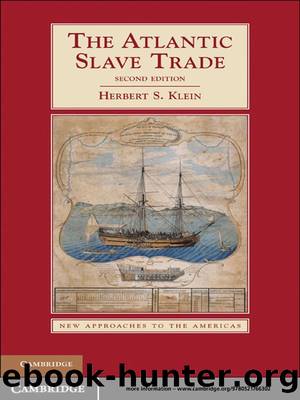The Atlantic Slave Trade by Herbert S. Klein

Author:Herbert S. Klein
Language: eng
Format: epub
Publisher: Cambridge University Press
Published: 2010-07-14T16:00:00+00:00
Obviously, this type of activity was more successful in the densely populated but small village systems common among the Ibio in this region. Such raiding would also have been common on the frontiers of larger states where well-integrated multicommunity states did not exist, as well as in more amorphous states where central authority was only lightly exercised at the local level. But in well-integrated states with professional soldiers, constant raiding by outsiders would have been difficult.
It would also be surprising for this type of raiding to go on for too long without a reaction from the local people, either in terms of banding together to protect themselves, or in migrating away from poorly defended places. That these Old Calabar canoe raiders were still using this method on the Cross River after a century of heavy slave trading in this zone seems highly unusual. To both trade and raid in the same area could only occur in places where raiding had not previously occurred on any major scale.
Individual acts of kidnapping in all regions are reported, and these less well-organized and smaller acts of capture were difficult to control even in the most powerful states. In many communities, in fact, kidnapping was considered a crime punishable by enslavement and was considered as serious as murder and adultery. It is also obvious that kidnapping could easily pass over to more structured raiding and that in times of crisis this activity was common.
Given the lack of formal jails, all crimes were either punished by physical acts or enslavement. Officials, royal pretenders, and rebel leaders were often executed. The Europeans reported with some regularity, for example, how the Dahomean king executed his local governors for malfeasance in office or because they represented a threat to his autocratic rule. In 1754 three successive viceroys of the Dahomean king in the port of Whydah were executed, along with two other lesser officials – all during times of internal peace. Murderers, and others considered to have committed vile acts against the community or the local religion, would be killed. But all the more common crimes such as theft, adultery, kidnapping, blasphemy, and witchcraft were usually punished with enslavement. Also, there appears to be enslavement for indebtedness. Though almost all states held that such judicially created slaves were to be used only as local domestic slaves, these judicial proceedings were abused in places, and such slaves were often sold to traders who removed these slaves from their home communities.
The relative importance of each of these means of enslavement must have varied by time and place. In a few well-defined cases, such as the complex trading and regional market network set up by the Aro peoples in what is today southeastern Nigeria between the Niger and Cross Rivers, it was evident that judicial activity with some low-level raiding was the prime source for slaves. In this, the most densely populated zone of West Africa, the Aro created a very complex market through the establishment of small colonies of peaceful traders among large groups of non-Aro peoples.
Download
This site does not store any files on its server. We only index and link to content provided by other sites. Please contact the content providers to delete copyright contents if any and email us, we'll remove relevant links or contents immediately.
| General | Discrimination & Racism |
Nudge - Improving Decisions about Health, Wealth, and Happiness by Thaler Sunstein(6694)
iGen by Jean M. Twenge(4737)
The Fire Next Time by James Baldwin(4409)
Adulting by Kelly Williams Brown(3726)
The Sports Rules Book by Human Kinetics(3637)
The Hacking of the American Mind by Robert H. Lustig(3626)
The Ethical Slut by Janet W. Hardy(3558)
Captivate by Vanessa Van Edwards(3344)
Mummy Knew by Lisa James(3194)
In a Sunburned Country by Bill Bryson(2987)
The Worm at the Core by Sheldon Solomon(2965)
Ants Among Elephants by Sujatha Gidla(2957)
Suicide: A Study in Sociology by Emile Durkheim(2639)
The Slow Fix: Solve Problems, Work Smarter, and Live Better In a World Addicted to Speed by Carl Honore(2600)
Humans of New York by Brandon Stanton(2402)
Handbook of Forensic Sociology and Psychology by Stephen J. Morewitz & Mark L. Goldstein(2394)
Blackwell Companion to Sociology, The by Judith R. Blau(2332)
The Happy Hooker by Xaviera Hollander(2299)
Outliers by Malcolm Gladwell(2285)
